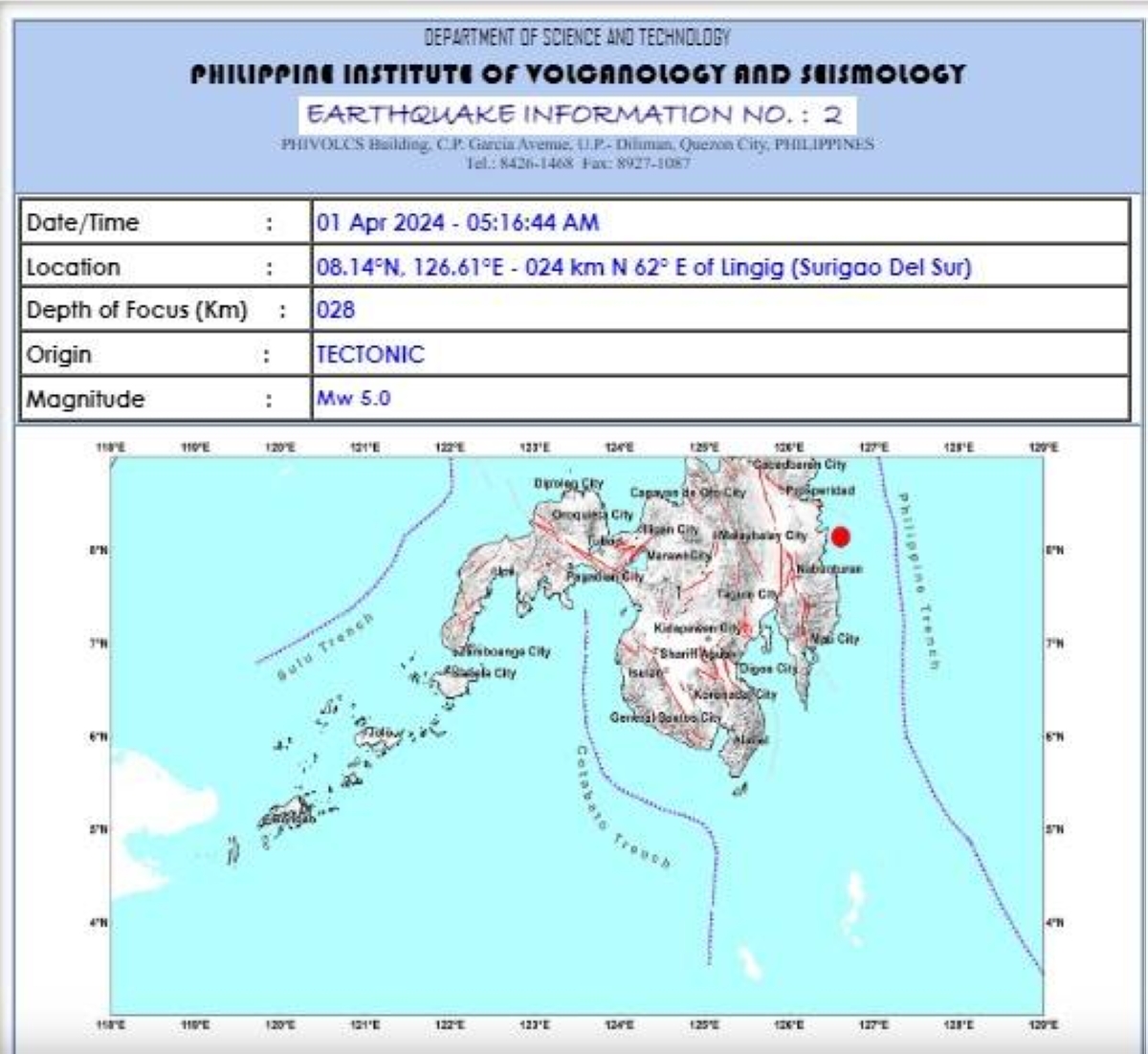The earthquake sent shockwaves throughout the province, causing panic and fear among the residents. The tremors were felt in neighboring towns and cities, including Tandag, Bislig, and Davao City. As news of the earthquake spread, people rushed out of their homes and sought shelter in open spaces, fearing aftershocks and potential building collapses.
Local authorities immediately activated their disaster response teams and conducted rapid assessments of the affected areas. The initial reports indicated that there were no casualties or major damages, but further investigations were underway to determine the extent of the impact. The local government, in coordination with national agencies, swiftly mobilized resources and provided assistance to affected communities.
The earthquake served as a reminder of the vulnerability of the Philippines to seismic activities due to its location along the Pacific Ring of Fire. This region is known for its high frequency of earthquakes and volcanic eruptions, making it one of the most seismically active areas in the world. The tectonic plates beneath the Philippines constantly shift and collide, resulting in frequent tremors.
In recent years, the Philippines has experienced several devastating earthquakes, such as the magnitude 7.2 earthquake in Bohol in 2013 and the magnitude 6.7 earthquake in Surigao City in 2017. These events have highlighted the importance of preparedness and resilience in mitigating the impact of natural disasters.
Efforts to strengthen disaster risk reduction and management in the country have been ongoing. The government has implemented various measures, including the establishment of early warning systems, the conduct of earthquake drills, and the enforcement of building codes to ensure structural integrity. However, there is still much work to be done to enhance the resilience of communities and infrastructure.
In the aftermath of the earthquake in Surigao del Sur, local authorities conducted thorough inspections of buildings, bridges, and other critical infrastructure to assess their safety. They also provided counseling and support to affected individuals and families who experienced trauma and anxiety as a result of the earthquake.
As the province recovers from the recent seismic event, it is crucial for the government, communities, and individuals to remain vigilant and proactive in disaster preparedness. This includes raising awareness about earthquake hazards, promoting community-based disaster risk reduction initiatives, and investing in resilient infrastructure.
The earthquake in Surigao del Sur serves as a wake-up call for the entire nation to prioritize disaster resilience and preparedness. It is a reminder that earthquakes can strike at any time, and the key to minimizing their impact lies in proactive planning, effective response, and continuous efforts to build a more resilient society.
Impact and Intensity
The earthquake that struck Surigao del Sur and its neighboring provinces had a significant impact on the affected areas. The varying intensities of the earthquake were felt differently across different locations, causing a range of experiences for the residents.
In the towns of Lingig and Hinatuan, the earthquake’s intensity was particularly strong, reaching a level 5 on the Modified Mercalli Intensity Scale. This means that residents in these areas experienced a vigorous shaking sensation, with some buildings sustaining moderate to severe damage. The ground movement was powerful enough to cause people to lose their balance and furniture to topple over.
Bislig City, located in Surigao del Sur as well, experienced a slightly lower intensity level of 4. Although the shaking was not as intense as in Lingig and Hinatuan, it was still significant enough to cause noticeable damage to buildings and infrastructure. Residents in Bislig City reported feeling a strong jolt and hearing loud noises during the earthquake.
Further south, in Boston, Davao Oriental, the intensity level dropped to 3. While the shaking was less severe compared to the previous locations, it was still enough to cause concern among residents. People in Boston felt a noticeable shaking, with some objects falling off shelves and minor structural damage occurring.
Instrumental intensity measurements, which are based on equipment readings rather than human perception, provided additional data on the earthquake’s impact. In Bislig, Surigao del Sur, and Nabunturan, Davao de Oro, instrumental readings recorded an intensity level of 3. These measurements confirm the human perception of the earthquake’s intensity in these areas, indicating that the shaking was indeed significant.
Overall, the earthquake had a varying impact on different areas, with Lingig and Hinatuan experiencing the strongest shaking. The damage caused by the earthquake ranged from moderate to severe, with buildings and infrastructure being particularly affected. The instrumental intensity measurements further validate the intensity levels reported by residents, providing a more comprehensive understanding of the earthquake’s impact on the affected regions. Local authorities have set up emergency response centers in affected areas to coordinate relief efforts and provide immediate assistance to those in need. These centers serve as hubs for gathering information about the extent of the damage, identifying areas that require urgent attention, and mobilizing resources to address the situation effectively.
One of the key aspects of local response and preparedness is the establishment of early warning systems. These systems include seismic monitoring stations that detect earthquake activity, allowing authorities to issue timely warnings to communities at risk. In the case of the recent earthquake in Surigao del Sur, PHIVOLCS was able to provide advance notice to residents, enabling them to take necessary precautions and evacuate if necessary.
In addition to early warning systems, local governments have also implemented measures to ensure the safety of critical infrastructure. Building codes and regulations have been put in place to ensure that structures are designed and constructed to withstand seismic events. Regular inspections are conducted to identify any structural weaknesses and address them promptly to minimize the risk of collapse during an earthquake.
Furthermore, local communities play a vital role in disaster preparedness. Public awareness campaigns are conducted to educate residents on earthquake safety measures, such as the “Drop, Cover, and Hold On” technique. These campaigns also emphasize the importance of having an emergency preparedness kit stocked with essential supplies, including food, water, medications, and first aid supplies.
Collaboration between local authorities, non-governmental organizations, and community-based organizations is crucial in ensuring an effective response to earthquakes. These partnerships enable the pooling of resources, expertise, and manpower to provide immediate relief and support to affected communities. Regular drills and simulations are conducted to test the efficiency of response plans and identify areas for improvement.
While efforts are being made to enhance local response and preparedness, it is important to acknowledge that earthquakes can be unpredictable and their impact can vary significantly. Therefore, it is essential for individuals and communities to remain vigilant and proactive in their preparedness efforts. By staying informed, following safety protocols, and participating in community-based initiatives, we can collectively work towards minimizing the devastating effects of earthquakes and building more resilient communities. The Pacific Ring of Fire is a highly active region with approximately 90% of the world’s earthquakes occurring along its boundaries. This is because the Ring of Fire is home to several major tectonic plates, including the Pacific Plate, the Philippine Sea Plate, and the Eurasian Plate. These plates are constantly moving and interacting with each other, causing intense geological activity.
One of the primary mechanisms behind earthquakes in the Philippines is the subduction of the Philippine Sea Plate beneath the Eurasian Plate. As the denser Philippine Sea Plate dives beneath the less dense Eurasian Plate, it creates a subduction zone. This subduction zone is characterized by intense pressure and friction, resulting in the buildup of stress over time. When the stress becomes too great, it is released in the form of an earthquake.
The Philippine archipelago is particularly susceptible to earthquakes due to its complex tectonic setting. Not only does it experience subduction along its eastern coast, but it also undergoes lateral movement along the Philippine Fault. The Philippine Fault is a major strike-slip fault that runs through the country and is responsible for numerous earthquakes. This fault is a result of the interaction between the Philippine Sea Plate and the larger Eurasian Plate.
In addition to the subduction and strike-slip activity, the Philippines is also affected by volcanic activity. Volcanic eruptions are closely linked to tectonic activity, as they are often associated with the movement of magma beneath the Earth’s surface. The presence of active volcanoes in the country, such as Mount Mayon and Mount Pinatubo, further contributes to the seismicity of the region.
Understanding the causes and patterns of earthquakes in the Philippines is crucial for disaster preparedness and mitigation efforts. By studying the tectonic activity in the region, scientists can better predict and assess the potential impact of future earthquakes. This knowledge can help in the development of effective early warning systems, building codes, and emergency response plans to minimize the loss of life and property during seismic events.
In conclusion, the Philippines’ location along the Pacific Ring of Fire exposes it to a high level of tectonic activity, resulting in frequent earthquakes. The subduction of the Philippine Sea Plate, the lateral movement along the Philippine Fault, and the presence of active volcanoes all contribute to the seismicity of the region. Understanding these processes is essential for the safety and well-being of the people living in this geologically active area.
Understanding Earthquake Preparedness
While earthquakes can strike without warning, being prepared can significantly reduce the risk of injuries and fatalities. It is not enough to simply know what to do during an earthquake; individuals and communities must also understand the science behind these natural disasters and how to mitigate their impact.
One of the most critical aspects of earthquake preparedness is creating an emergency plan. This plan should outline the steps to take before, during, and after an earthquake. It should include identifying safe spots in your home or workplace, as well as establishing a communication plan with your family or household members. This plan should be regularly reviewed and practiced to ensure that everyone is familiar with the procedures.
In addition to having an emergency plan, it is essential to prepare an emergency kit. This kit should include enough food, water, medication, and first aid supplies to sustain you and your family for at least three days. It should also contain essential items such as a flashlight, batteries, and a portable radio to stay informed about the latest updates from local authorities.
Securing heavy objects within your home or workplace is another crucial step in earthquake preparedness. Unsecured furniture, appliances, and objects can become dangerous projectiles during an earthquake, causing severe injuries or even death. By using wall brackets or straps, you can prevent these items from falling and potentially harming you or your loved ones.
Staying informed is also vital during an earthquake. It is essential to follow the guidance and instructions provided by local authorities and trusted news sources. This includes knowing the location of evacuation centers, designated safe areas, and emergency contact numbers. By staying updated, you can make informed decisions that will help keep you and your community safe.
Regularly practicing earthquake drills is another crucial aspect of preparedness. These drills should simulate the actions you would take during an actual earthquake, such as “Drop, Cover, and Hold On.” By practicing these drills, you can reduce panic and improve response time, increasing the chances of survival in the event of an earthquake.
Remember, earthquake preparedness is a continuous effort. It requires ongoing education, planning, and practice. By taking the necessary precautions and staying informed, you can ensure your safety and the safety of those around you during an earthquake.







